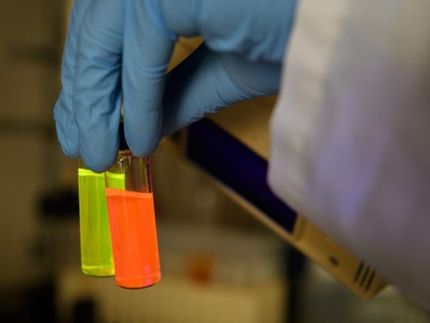'Color-blind' method opens new doors in DNA sequencing
A "color-blind" method of fluorescence detection developed by researchers at Baylor College of medicine and rice University could open new doors that would take DNA sequencing to the patient's bedside, the doctor's office and even the scene of a crime or a battlefield.
"We could eventually do direct detection of a DNA sequence from native DNA without manipulation now performed in the laboratory," said Dr. Michael L. Metzker, assistant professor in the BCM Human Genome Sequencing Center. "We could make sequencing portable and do it faster."
In a report t in the journal Proceedings of the National Academy of Sciences, Metzker and colleagues from BCM and Rice described a new way of doing DNA sequencing that could be more accurate than techniques currently in use. Particular fluorescent dyes are tagged to the bases - A, C, G, or T - in the DNA to be sequenced. In the previous method, the dyes interact with a single laser and give off light that is then spectrally separated into blue, green, yellow and red. The order of the dye's color determines the DNA sequence. The new method, called pulsed multiline excitation, uses four lasers, each matched to a particular dye. PME enables the researchers to take advantage of the entire visible spectrum, eliminating the problem of "cross-talk" between the dyes that made the old method less accurate, said Metzker.
Because there are four lasers, scientists can manipulate the system so that each dye gives the same intensity of fluorescent signal, eliminating the need for further software processing to yield readable sequence information. "We have built a highly sensitive instrument for the measuring of fluorescence," he said, "because PME gives brighter signals and collects more of that signal by eliminating the need for a prism to separate the light into colors."
Metzker is also seeking to develop a chip-based imager than could be used in his overall project on sequencing-by-synthesis, which is funded by the National Human Genome Research Institute. This project could lead to the ability to sequence an individual's own genome rapidly and inexpensively. Metzker and the major developers of this technology filed a patent on PME in 2001, which has been exclusively licensed to LaserGen for commercial development.
Most read news
Topics
Organizations
Other news from the department science
These products might interest you

Limsophy by AAC Infotray
Optimise your laboratory processes with Limsophy LIMS
Seamless integration and process optimisation in laboratory data management

LAUDA.LIVE by LAUDA
LAUDA.LIVE - The digital platform for your device management
Comprehensive fleet management options for every LAUDA device - with and without IoT connectivity

Get the analytics and lab tech industry in your inbox
From now on, don't miss a thing: Our newsletter for analytics and lab technology brings you up to date every Tuesday. The latest industry news, product highlights and innovations - compact and easy to understand in your inbox. Researched by us so you don't have to.



![[Fe]-hydrogenase catalysis visualized using para-hydrogen-enhanced nuclear magnetic resonance spectroscopy](https://img.chemie.de/Portal/News/675fd46b9b54f_sBuG8s4sS.png?tr=w-712,h-534,cm-extract,x-0,y-16:n-xl)





















































